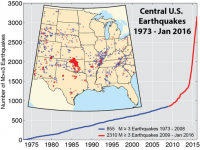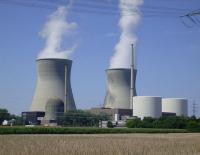-
Bolstering energy security with homegrown energy sources
The U.S. Department of Energy has a goal to develop and demonstrate transformative bioenergy technologies to fuel a more sustainable nation. Reaching that goal will require roughly a billion tons of biomass, so we will need to rely on a variety of resources to get the job done.
-
-
Coal's decline driven by technology, market forces – not policy
Many people – and many politicians — attribute coal’s decline to the clean-air policies of the federal Environmental Protection Agency (EPA) through rules that the agency applied to electricity generation plants. A new study points out that largely because of court challenges, EPA clean-air regulations did not change until 2015 — twenty-five years after President G. H. W. Bush signed amendments to the Clean Air Act in 1980. For eighteen years following new EPA rules, coal continued to thrive — until 2008, when its production peaked and then declined 23 percent in the next seven years. The study found that the decline is correlated with the shale revolution that began to be fully felt in 2007-2008, after which cheap natural gas outcompeted coal markedly.
-
-
Coal's decline driven by technology, market forces – not policy
Many people – and many politicians — attribute coal’s decline to the clean-air policies of the federal Environmental Protection Agency (EPA) through rules that the agency applied to electricity generation plants. A new study points out that largely because of court challenges, EPA clean-air regulations did not change until 2015 — twenty-five years after President G. H. W. Bush signed amendments to the Clean Air Act in 1980. For eighteen years following new EPA rules, coal continued to thrive — until 2008, when its production peaked and then declined 23 percent in the next seven years. The study found that the decline is correlated with the shale revolution that began to be fully felt in 2007-2008, after which cheap natural gas outcompeted coal markedly.
-
-
Abnormalities found in drinking water in Texas’s Eagle Ford Shale region
Chemists studying well water quality in the Texas’s Eagle Ford Shale region found some abnormal chloride/bromide ratios, alongside evidence of dissolved gases and sporadic episodes of volatile organic compounds, all indicative of some contamination from industrial or agricultural activities in the area.
-
-
Oklahoma shuts down 37 wells after Saturday’s 5.6 magnitude earthquake

Oklahoma ordered the shutting down of 37 wells after Saturday’s 5.6 magnitude earthquake. Experts note that the significant increase in the number earthquakes measuring 3.0 or higher in Oklahoma has been linked to the practice of underground disposal of wastewater from oil and natural gas production. Only three earthquakes 3.0 magnitude or higher were recorded in 2009. Last year, the state had 907 such quakes. So far this year, there have been more than 400.
-
-
Solar-powered Ring Garden combines desalination, agriculture for drought-stricken California
With roughly 80 percent of California’s already-scarce water supply going to agriculture, it is crucial for the state to embrace new technologies that shrink the amount of water required to grow food. Alexandru Predonu has designed an elegant solution which uses solar energy to power a rotating desalination plant and farm that not only produces clean drinking water for the city of Santa Monica, but also food crops — including algae.
-
-
Preventing human-caused, fracking-related earthquakes

The 31 May 2014 earthquake that rumbled below Colorado’s eastern plains surprised both local residents and local seismologists. The earthquake happened in an area that had seen no seismic activity in at least four decades. It was likely caused by the injection of industrial wastewater deep underground. New research shows actions taken by drillers and regulators can lessen risk in the case of earthquakes likely caused by the injection of industrial wastewater deep underground.
-
-
Wider temperature tolerance is based on ion-pair-coordinated polymers
A new class of fuel cells based on a newly discovered polymer-based material could bridge the gap between the operating temperature ranges of two existing types of polymer fuel cells, a breakthrough with the potential to accelerate the commercialization of low-cost fuel cells for automotive and stationary applications.
-
-
Pro-nuclear countries slowest to make progress on climate targets

A strong national commitment to nuclear energy goes hand in hand with weak performance on climate change targets, researchers found. A new study of European countries shows that the most progress toward reducing carbon emissions and increasing renewable energy sources has been made by nations without nuclear energy or with plans to reduce it. Conversely, pro-nuclear countries have been slower to implement wind, solar, and hydropower technologies and to tackle emissions.
-
-
NSF announces $55 million toward national research priorities
The National Science Foundation (NSF) has made eleven awards totaling $55 million aimed at building research capacity to address fundamental questions about the brain and develop new innovations at the intersection of food, energy, and water systems. These four-year awards support twenty-seven institutions in eighteen eligible jurisdictions.
-
-
How to generate energy during earthquakes
Physics students from the University of Leicester have explored a feasible way to harness the power of earthquakes during a disaster in order to keep vital systems powered. By using a magnet inside a coil during the shaking of tectonic plates that occurs during an earthquake, the students suggest that the magnetic field created by the shaking could generate a current which could potentially be harnessed.
-
-
Climate risk and the fossil fuel industry
Burning coal, oil, and natural gas is responsible for two-thirds of the world’s greenhouse gas emissions. Yet these same fuels are also the economic mainstay of resource-rich countries and the world’s largest companies. According to a new study, this means that climate-change relief actions represent danger for the fossil fuel business.
-
-
As nuclear power plants close, states need to bet big on energy storage
Nuclear power plants saw their heyday in the early 1970s and were praised for their ability to produce large amounts of electricity at a constant rate without the use of fossil fuels. We are now observing a trend whereby long-running nuclear power plants are shutting down, and of utilities moving toward renewable electricity generation, such as solar and wind. Can utilities supply electricity around the clock using these alternative generation sources? And crucially, can energy storage technologies provide the power on demand that traditional generators have done? It is clear that energy storage is the major limitation to achieving a carbon-free electricity grid. Careful planning is needed to ensure that energy storage systems are installed to take over the baseline load duties currently held by natural gas and nuclear power, as renewables and energy efficiency may not be able to carry the burden.
-
-
80% of EU oil imports now supplied by non-European companies
Non-European companies supply four-fifths of Europe’s oil imports, with Russian firms supplying more than one-third (36 percent) of imported crude, a new study on Europe’s foreign oil dependency has found. Just two of the top ten oil suppliers to the EU are European, and most of our imported oil is supplied from unstable countries.
-
-
Huge helium discovery in Tanzania is “a life-saving find”
Helium does not just make your voice squeaky — it is critical to many things we take for granted, including MRI scanners in medicine, welding, industrial leak detection, and nuclear energy. However, known reserves are quickly running out. Until now helium has never been found intentionally — being accidentally discovered in small quantities during oil and gas drilling. Researchers have developed a new exploration approach, and the first use of this method has resulted in the discovery of a world-class helium gas field in Tanzania.
-
- All
- Regional
- Water
- Biometrics
- Borders/Immig
- Business
- Cybersecurity
- Detection
- Disasters
- Government
- Infrastructure
- International
- Public health
- Public Safety
- Communication interoperabillity
- Emergency services
- Emergency medical services
- Fire
- First response
- IEDs
- Law Enforcement
- Law Enforcement Technology
- Military technology
- Nonlethal weapons
- Nuclear weapons
- Personal protection equipment
- Police
- Notification /alert systems
- Situational awareness
- Weapons systems
- Sci-Tech
- Sector Reports
- Surveillance
- Transportation
Advertising & Marketing: advertise@newswirepubs.com
Editorial: editor@newswirepubs.com
General: info@newswirepubs.com
2010-2011 © News Wire Publications, LLC News Wire Publications, LLC
220 Old Country Road | Suite 200 | Mineola | New York | 11501
Permissions and Policies
Editorial: editor@newswirepubs.com
General: info@newswirepubs.com
2010-2011 © News Wire Publications, LLC News Wire Publications, LLC
220 Old Country Road | Suite 200 | Mineola | New York | 11501
Permissions and Policies
